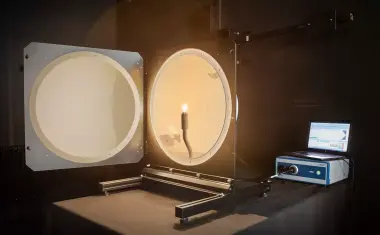What are the Inherent Fire Risks of Modern Battery Technology?
Videos of electro-scooters and electric cars bursting into flames while charging have been seen around the world. They make headlines, at least locally, almost every time, and have been responsible for significant damage and even loss of life. For all those that do catch fire, there are of course many thousands more that do not. Nevertheless, the inherent fire risk is there with every battery-powered – or more accurately, accumulator-powered – vehicle or device. Has fire-fighting and fire-containment technology kept up with the technological progress of these ‘batteries’?
Common language usage does not distinguish between one-time batteries and rechargeable accumulators, calling them both just ‘batteries’. While this has caused a number of domestic non-rechargeable cells to explosively splatter their carbon cores and gel because someone has not read the small print on the side and tried to recharge them, even the common lithium-ion (Li-ion) or nickel-cadmium (NiCad) rechargeable types can sometimes leak or even catch fire when incorrectly charged or physically damaged. A small fire can be contained by dropping the device into water and standing well back to avoid inhaling poisonous fumes, if it is discovered early enough. A stack of cells or a large pile of rechargeable batteries in a warehouse, however, presents an entirely different problem. Once one cell has caught fire, it will quickly overheat adjacent cells and cause an almost logarithmic growth of the conflagration – the dreaded runaway effect.
What is the Challenge With Electric Vehicle Batteries?
Batteries for vehicles by design must have a high energy-density and be able to rapidly provide a high current. They must be able to be recharged quickly too, which is why manufacturers of car batteries are predominantly using lithium-iron-phosphate, nickel-cobalt-aluminum, or nickel-cobalt-magnesium chemistry in their products. Fire brigades have a significant problem when these catch fire because the batteries are mounted underneath the vehicle and they cannot be extinguished with conventional mobile fire-fighting equipment. They are dealing with an exothermic chemical chain reaction that is unaffected by most foam extinguishants, and really can take days to become inactive. The ever-present danger is that a damaged battery will re-ignite even after apparently having been extinguished.
Mobile baths have been introduced to drop a whole electric car into and cool down the battery, a highly effective method of suppressing the reaction, stopping the fire from getting completely out of control, and transporting the vehicle away to a safe place. Alternatively, a multi-faceted approach using fire blankets, aerosols and a fine water spray is offered by T-Iss from the Netherlands with their Fire Isolator concept.

How Do You Put Out A Battery Fire?
CO², powder or foam extinguishers will only have a limited effect and will probably not extinguish the fire, but one method is universally used: cooling. Helbig Feuerschutz supply a gel that forms an airtight seal over a fire and cools it. It can be sprayed onto the battery fire and it sticks to the surfaces it touches. This is of course ideal for recycling centers for example, where objects made of many different materials are heaped together. Smaller gel-based extinguishers are also affordable and applicable for the initial firefighting of small domestic battery fires.
Extinguishers have been developed to fight lithium compound fires that apply a watery silicon crystal mix. The working principle – also that of aqueous vermiculite dispersion (AVD) – is that tiny sheets of silicon expand with the heat and melt to form an impenetrable layer that reduces the surrounding temperature and prevents further thermal runaway. LionCare will be happy to advise you further about these as well as fire blankets and so-called ‘pyrobubbles’. These are often used in granulate form during the transport of lithium-based cells and can withstand extremely high temperatures.
Stateside, StatX can provide you with a simple aerosol-based method of suppressing fires. They have various models appropriate for the size of the risk and the industry, and these can be either manually activated, automatic, or coupled with a separate fire detection system.
Fire Safety Sticks
The Fire Safety Stick has been fully certified by independent third party European testing houses to extinguish fires of types A, B, C, F and consumer voltage electrical fires. The stick contains mostly potassium nitrate, and is started by igniting the top compound with the striker. A chemical reaction breaks the potassium nitrate down into nitrogen gas and potassium free radicals, pushing the potassium ions out to rapidly oxidize in the air and remove the oxygen from the fire. The resulting tiny inert potassium oxide particles simply dissipate into the atmosphere, without any harmful effects. The stream of extinguishant lasts from around 45 to 90 seconds. These sticks are marketed under various different names around the world but all use the same principle to suppress and possibly – hopefully – extinguish a fire. Subsequent cooling is still essential though. If you are in South Africa, you could contact Firebreak SA who have these sticks among their extensive range of safety devices, while you will find comprehensive information about these products and where to obtain them elsewhere on the Fire Safety Stick website.
A Case For Fire Blankets
In some cases, it makes no sense to actually fight a lithium fire once it has established itself, but only to limit the damage it can cause. This can be achieved by using fire blankets, which are available in various sizes depending on the expected risk: box size, forklift truck size, car size, and bigger. They will withstand over 1,000°C to 2,500°C for a short time, and 700 – 1,500 °C continuously, depending on the model. These blankets provide a valuable delay in a lithium fire spreading before the firefighters arrive. The not very Norwegian-sounding company Bridgehill has a useful selection of blankets and other fire containment products available.
For smaller battery packs such as those used in hand tools or garden tools, radio-controlled models, or portable audio devices, there are LiPO bags available for the transport of the cells/batteries. These are especially beneficial when the battery has just been charged and has its highest fire potential. The bags do not put out a battery fire, but they do contain it and bring some valuable seconds to quickly move the bag away from nearby inflammable materials or outside. The aptly-named Brimstone company has fire bags to fit all sorts of smaller contemporary electronic devices for safe transport to minimize the risk of expensive material damage or consequential court proceedings.
If you’re handy with a sewing machine, you might like to make your own custom-sized bag using material from SVT Global. They can provide a non-woven glass fiber fabric with an integrated intumescent [viz. swelling] fire protection coating that provides passive fire protection in diverse e-mobility battery environments.
Yet Another Battery Risk
Large concentrations of batteries are now found at solar panel and wind turbine installations to buffer unused energy when the sun shines bright and the wind blows, and also at other more traditional types of power generation plant for the same purpose. The recent fire disaster at one of the hitherto largest battery power storage facilities worldwide at Moss Landing in California with 3,700 MWh of energy capacity has clearly demonstrated that there is still a lot of work to be done before this technology becomes totally trouble-free.
Battery energy storage systems (BESS) are rapidly being built around the world close to solar and wind-generated electricity plants to buffer the production and demand imbalance. Despite using the best engineering practices and as demonstrated in the example above, fires do still occur at such sites, either in the generating equipment, in overheated cables, regulation equipment or switchgear, or in the cabin of a wind turbine. They have proven stubborn to extinguish so far, and just letting them burn does not qualify as acceptable fire suppression.
Almost all storage systems built to date use lithium-ion cells, with the corresponding fire risk. Recommended alternatives however would be sodium-ion, zinc-based and iron-air batteries, which are less prone to thermal runaway. Gesip have decades of experience in mitigating such risks and can provide a helping hand when you are wading through all the options, the legislation and the implementation of industrial safety solutions. Fire Trace International in N. America have a whole arsenal of fire-fighting solutions available for the protection of solar/battery storage installations. Nobel Fire Systems supply various different extinguishing technology solutions – gas, water mist, foam, or chemical – appropriate for the risk, directly in the UK and through their many distributors worldwide.
Wind of Change
There is thankfully a slow progression underway in domestic usage from lithium-ion technology to more modern and more efficient nickel metal-hydride (Ni-MH) and lithium iron phosphate (LiFePO4) types, both of which are much less susceptible to thermal runaway and will not catch fire when damaged. In the pipeline are even more new methods of storing electrical energy, such as solid-state and lithium-sulphur batteries which, although not good for the sales statistics of the companies that we have mentioned here, will be a relief to firefighters and insurance companies worldwide.












